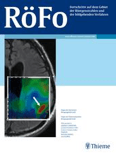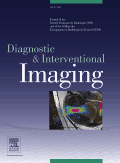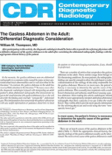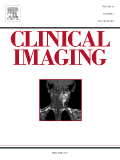
SEMINARS IN ROENTGENOLOGY
Scope & Guideline
Transforming Radiology Through Comprehensive Reviews
Introduction
Aims and Scopes
- Pediatric Imaging:
The journal emphasizes pediatric imaging, covering a wide range of topics from congenital disorders to acute emergencies, thus addressing the unique challenges and considerations in imaging children. - Neuroimaging and Cerebrovascular Disorders:
There is a significant focus on neuroimaging, particularly in cerebrovascular conditions, highlighting advancements in imaging techniques and their implications for diagnosis and treatment. - Cardiovascular Imaging:
The journal explores innovations in cardiovascular imaging, especially related to structural heart disease and interventions, providing insights into the role of imaging in treatment planning. - Artificial Intelligence in Radiology:
A notable area of interest is the application of artificial intelligence in radiology, discussing its potential to enhance imaging workflows, diagnostic accuracy, and patient outcomes. - Interventional Radiology:
The journal addresses interventional radiology practices, particularly in the context of transcatheter interventions and image-guided procedures, emphasizing the integration of imaging in therapeutic approaches. - Emerging Imaging Techniques:
SEMINARS IN ROENTGENOLOGY covers new and emerging imaging modalities and techniques, such as 4D imaging and photon counting CT, to keep practitioners informed about the latest advancements.
Trending and Emerging
- Enhanced Pediatric Imaging Techniques:
Recent publications indicate a growing emphasis on pediatric imaging, particularly in addressing complex conditions and emergencies, reflecting the need for specialized knowledge in this area. - Integration of AI in Clinical Practice:
The increasing focus on artificial intelligence highlights its relevance in streamlining workflows and improving diagnostic accuracy, marking a significant trend in radiology. - Innovations in Neurovascular Imaging:
Emerging themes around advanced neurovascular imaging techniques demonstrate a shift towards better understanding and managing cerebrovascular disorders, showcasing technological advancements. - Transcatheter Interventions and Imaging Techniques:
There is a rising trend in discussing imaging techniques related to transcatheter interventions, emphasizing the critical role of imaging in guiding and evaluating these procedures. - Diversity, Equity, and Inclusion in Radiology:
Recent discussions around diversity and inclusion reflect a broader awareness and commitment to addressing disparities in the field, indicating a cultural shift within the radiological community.
Declining or Waning
- Traditional Musculoskeletal Imaging:
There is a noticeable reduction in traditional musculoskeletal imaging topics, possibly due to advancements in imaging modalities that provide more detailed and accurate assessments. - General Imaging Techniques:
General discussions on imaging techniques without specific clinical context are becoming less common, indicating a shift towards more specialized and focused content in the journal. - Infectious Disease Imaging:
Papers specifically addressing infectious disease imaging, particularly in non-pulmonary contexts, seem to be less frequent, possibly due to a broader focus on more pressing areas of radiological research. - Breast Imaging:
Although still relevant, breast imaging topics appear to be receiving less attention compared to other emerging areas, suggesting a potential waning interest in this specific subfield.
Similar Journals

EUROPEAN RADIOLOGY
Illuminating the Path to Radiological AdvancementEUROPEAN RADIOLOGY, published by SPRINGER, stands as a prestigious international journal in the field of radiology, nuclear medicine, and imaging, with an impressive impact factor that underscores its significance among peers. With an ISSN of 0938-7994 and an E-ISSN of 1432-1084, this journal provides a platform for cutting-edge research and advancements in medical imaging from 1991 to 2024. Recognized as a Q1 journal in both general Medicine and the specialized Radiology category by 2023, EUROPEAN RADIOLOGY ranks an impressive #17 out of 333 in its field according to Scopus, placing it in the 95th percentile. While it does not currently offer Open Access options, the journal remains essential reading for researchers, professionals, and students striving to stay at the forefront of developments in diagnostic imaging and related technologies. By contributing to a comprehensive understanding of radiological practices, EUROPEAN RADIOLOGY plays a crucial role in shaping the future of medical diagnosis and patient care.

ROFO-FORTSCHRITTE AUF DEM GEBIET DER RONTGENSTRAHLEN UND DER BILDGEBENDEN VERFAHREN
Illuminating Innovations in Imaging and TherapyROFO-Fortschritte auf dem Gebiet der Röntgenstrahlen und der bildgebenden Verfahren, published by Georg Thieme Verlag KG, is a pivotal journal in the fields of radiology and nuclear medicine, offering invaluable insights for researchers, healthcare professionals, and students alike. With an ISSN of 1438-9029, this journal has been a stalwart of scientific communication since its inception in 1975, actively contributing to advancements in imaging techniques and radiation therapy. Although it operates under traditional access, the journal maintains a respectable standing, reflected by its Q3 ranking in Radiology, Nuclear Medicine and Imaging and Q4 in Medicine (miscellaneous), highlighting its significance in the scholarly community. Its coverage spans a wide array of topics pertinent to diagnostic imaging and therapy protocols, making it an essential resource for anyone seeking to understand the complexities of modern radiological practices. As the journal continues to evolve through 2024, it invites contributions that enrich the dialogue around technological innovations and clinical applications in the realm of imaging modalities.

Diagnostic and Interventional Imaging
Leading the Way in Diagnostic and Interventional BreakthroughsDiagnostic and Interventional Imaging, published by Elsevier Masson, stands as a prominent journal in the fields of Radiology, Nuclear Medicine, and Imaging. With a significant impact factor and a reputation for high-quality research, this journal is dedicated to advancing the understanding and application of diagnostic and interventional imaging techniques. It has achieved an impressive Q1 ranking across multiple categories including Medicine (miscellaneous) and Radiological and Ultrasound Technology, demonstrating its esteemed position within the academic community. The journal features cutting-edge studies and reviews, reflecting the latest innovations and practices from 2012 to 2024. Researchers, healthcare professionals, and students alike can look forward to accessing valuable insights that drive forward the discipline and improve patient outcomes, as evidenced by its robust Scopus rankings placing it among the top journals in its domain.

Hong Kong Journal of Radiology
Shaping the Future of Medical Imaging ResearchHong Kong Journal of Radiology, an esteemed publication of the Hong Kong Academy of Medicine Press, serves as a vital platform for disseminating innovative research in the field of radiology, nuclear medicine, and imaging. Established in 2011 and operating under an Open Access model since 2018, this journal not only promotes the sharing of knowledge but also enhances global accessibility to cutting-edge studies. With its ISSN 2223-6619 and E-ISSN 2307-4620, the journal strives to engage a diverse audience ranging from experienced professionals to aspiring scholars in the medical imaging domain. Despite its current ranking in the Q4 quartile of the Scopus category for radiology, the journal is committed to improving its standing by featuring high-quality research that addresses pressing issues in the field. The journal's convergence from 2011 to 2024 reflects its ongoing dedication to fostering academic excellence and encouraging collaborative discourse among researchers and practitioners globally. Located in Hong Kong, the journal plays a significant role in shaping the future of radiology education and practice in China and beyond.

Contemporary Diagnostic Radiology
Exploring the Future of Imaging TechniquesContemporary Diagnostic Radiology is a pivotal journal in the field of medical imaging and radiology, published by Lippincott Williams & Wilkins. With an ISSN of 0149-9009 and an E-ISSN of 1938-1395, this journal serves as an essential platform for disseminating high-quality research and advances in diagnostic radiology and related disciplines. While it is categorized in the lower quartiles (Q4) for its performance in the 2023 rankings in both Neurology, Radiology, Nuclear Medicine and Imaging, and Surgery, its focus on emerging technologies and methodologies in imaging continues to provide valuable insights for practitioners and researchers alike. The journal’s scope includes innovative diagnostic tools, imaging techniques, and case studies, fostering collaboration and knowledge sharing in the medical community. Although it does not offer open access options, its commitment to contributing to the ongoing dialogue in clinical imaging is undisputed, making it an essential resource for professionals seeking to stay abreast of current trends and research in the rapidly evolving landscape of diagnostic radiology.

Clinical Imaging
Advancing the Future of Diagnostic ImagingClinical Imaging, published by Elsevier Science Inc, is a renowned journal dedicated to the field of radiology, nuclear medicine, and imaging. With an ISSN of 0899-7071 and an E-ISSN of 1873-4499, this esteemed publication has established its significance in advancing imaging science since its inception in 1989 and continues to make impactful contributions to the discipline through 2024. The journal holds a prestigious Q2 ranking in the category of Radiology, Nuclear Medicine, and Imaging, reflecting its critical role in bridging research and clinical practice. Currently ranked #113 out of 333 by Scopus, with a notable 66th percentile, it offers a platform for disseminating high-quality research, reviews, and case studies that inspire innovation and enhance imaging techniques. Although it primarily functions as a subscription-based journal, it remains dedicated to accessibility and the dissemination of pivotal findings that inform both academia and clinical settings. Clinical Imaging is essential for researchers, professionals, and students alike, offering insights that shape the future of diagnostic imaging.

Imaging
Empowering Collaboration in Medical ImagingImaging, published by AKADEMIAI KIADO ZRT, is an esteemed open-access journal dedicated to the field of medical imaging, established in 2020. With an E-ISSN of 2732-0960 and based in Budapest, Hungary, this journal provides a vital platform for the dissemination of cutting-edge research and advancements in imaging techniques, especially in the realms of radiology, nuclear medicine, and ultrasound technology. While currently positioned in the Q4 category across multiple medical specialties, the journal continues to strive for improvements in visibility and impact, contributing to the evolving discourse in medical imaging. The journal aims to facilitate an inclusive and collaborative environment for researchers, professionals, and students, inviting them to share their findings and insights to enhance the field's development. With open-access availability since its inception, Imaging ensures free and easy access to its content, fostering a greater understanding and appreciation of innovative imaging practices worldwide.

KOREAN JOURNAL OF RADIOLOGY
Innovating the Future of Medical ImagingKorean Journal of Radiology (ISSN: 1229-6929, E-ISSN: 2005-8330), published by the Korean Society of Radiology, stands as a leading international platform for the dissemination of high-quality research and advancements in the fields of radiology, nuclear medicine, and imaging. With a remarkable impact factor and ranked in the Q1 quadrant in its category, this journal showcases cutting-edge studies, clinical investigations, and comprehensive reviews that significantly contribute to the understanding and practice of medical imaging. Researchers, clinicians, and students alike will find the journal an invaluable resource, featuring innovative methodologies, case studies, and essential updates in imaging technology. Since its inception in 2000 and continuing through 2024, the Korean Journal of Radiology remains dedicated to promoting excellence and fostering collaborative research within the global radiology community, underscoring the importance of imaging in modern medicine.

SEMINARS IN MUSCULOSKELETAL RADIOLOGY
Bridging Research and Practice in Musculoskeletal HealthSEMINARS IN MUSCULOSKELETAL RADIOLOGY is a leading journal in the fields of Orthopedics and Sports Medicine, as well as Radiology, with a strong emphasis on advancing the understanding and application of imaging techniques in musculoskeletal disorders. Published by THIEME MEDICAL PUBL INC, this esteemed journal boasts a reputation for high-quality, peer-reviewed articles that span essential topics ranging from diagnostic imaging methods to innovative therapeutic strategies. With its ISSN 1089-7860 and E-ISSN 1098-898X, the journal is a vital resource for researchers, clinicians, and students eager to stay updated on the latest developments in musculoskeletal imaging. Notably positioned in the Q3 category for both Orthopedics and Sports Medicine and Radiology, Nuclear Medicine and Imaging, it serves as an essential platform for sharing pioneering research and clinical practices that enhance patient care. Operating in a traditionally challenging landscape for publication access, its focus remains on rich, impactful content that resonates with the academic community, despite currently non-open access delivery. Since its inception in 1999, the journal has endured, adapting to the ever-evolving medical landscape and continues to contribute significantly to the scientific body of knowledge through 2024 and beyond.

AMERICAN JOURNAL OF ROENTGENOLOGY
Empowering Healthcare through Imaging Knowledge.AMERICAN JOURNAL OF ROENTGENOLOGY (AJR), published by the American Roentgen Ray Society, stands as a beacon of excellence in the fields of Radiology, Nuclear Medicine, and Imaging. With an impressive impact factor positioning it in the Q1 category of both Medicine (Miscellaneous) and Radiology as of 2023, AJR is ranked 13th out of 333 journals in its category, reflecting its prominent presence and high relevance in advancing medical imaging knowledge and practice. Established in 1973 and continuing through to 2024, the journal encompasses a broad spectrum of research, critical reviews, and innovative techniques, making it a vital resource for researchers, healthcare professionals, and students alike. Although it does not currently offer open access options, AJR ensures that its rigorous, peer-reviewed content remains accessible to a global audience committed to the evolution of radiological science. With its home base in Leesburg, Virginia, AJR not only informs but also inspires advancements in radiology, enhancing diagnostic practices and patient care globally.